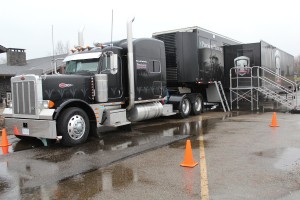CANTON, Ohio — One of the most important factors that determines the yield of corn and soybeans is how the seed is planted.
With that in mind, about 100 area farmers spent a rainy day March 10 learning how they can do a better job of planting more efficiently, and with more precision.
The Precision Planting Co. brought its mobile planting theater to the Skyland Pines Golf Club, located between Canton and Alliance, where two groups of farmers gathered to learn about the latest in precision planting.
Farm feel
Unlike movie theater seats, these seats were designed to look and feel like tractor seats, with a metal footrest, and armrests similar to those found inside farm tractors.
There was no popcorn, and no lengthy movie previews to sit through. Instead, Matt Bennett, regional sales manager for Precision Planting, got right to the reason farmers came: how to increase their efficiency and crop profitability.

Bennett said precision planting allows farmers to make “small incremental gains,” and some really big gains — depending on how they’re already farming.
His company, Precision Planting, offers farmers a variety of planter modifications that can be made to new planters as well as used planters.
“The planter of the future is already in your barn,” Bennett said, explaining that farmers can upgrade what they already own.
Precision Planting offers a number of solutions, including “vSet Select,” which allows farmers to switch between two hybrids across the same field, and even the same row; “eSet,” to control variation in seed size and shape; “Precision Meters” to prevent seed skips and doubles; SpeedTube, for increasing speed; computer monitoring programs like “20/20 SeedSense” and “YieldSense;” and various down force systems, to ensure seeds get good soil contact and soil placement.
Timely issue
The concept of precision agriculture is nothing new, but because profit margins are tight this year, some farmers are finding that it makes more sense.
“In a $3.50 corn market, every bushel is worth more now than it is in a $6 market,” Bennett said. “Your fixed overhead doesn’t change, so you have got to make those bushels count.”
The Precision Planting demo was sponsored by Agland Co-op. Agland staffers are trained in Precision Planting technology, and can help farmers improve their planters.
Mark Smith, precision specialist for Agland, said some of the technology is still new to northeast Ohio, but is catching on. He wanted to bring the program to Canton so farmers could see first-hand what a difference precision planting makes.
“There’s just a lot of small changes that can be made to a lot of these older planters, that guys don’t have to go out and buy new planters,” Smith said.
The technologies offered by Precision Planting cover everything from seed placement, spacing and depth, to the amount of pressure and weight put on each seed.
Even minor variations can affect yield, Bennett explained, especially in the first few stages of plant growth, when things like ear size and number of kernel rows are being determined.
Data driven
The goal of Precision Planting is to achieve uniformity and to help farmers go “from fingers crossed, to data driven,” Bennett said.
He said farmers often think they can control things like down force and planter elevation, but because of irregular fields and changes in slope, it’s more complicated than farmers realize.
Less waste
Nolan Schlabach, who farms near Sugarcreek, said his planters already have many of the technologies offered by Precision Planting. He said the technology does a good job of compensating for irregular-shaped fields, and differing soil types.
“It’s a money-savings on seeds,” Schlabach said.
Brendon Miller, of the Blue Ridge Dairy farm near Newcomerstown, said the technology has helped him achieve uniform seed depth in fields that aren’t always flat and uniform.
He feels his planters waste less seed, and is hoping for even more efficiency, as he begins experimenting with variable rate planting.
In addition to the economic benefits, precision planting also helps farmers do a better job of managing nutrients.
Bennett is doing research on planting into standing cover crops in an effort to protect nutrients and soil particles from runoff.
He encouraged farmers to keep growing cover crops because, as environmental concerns mount, cover crops could eventually become a requirement.
“In the not-so-distant future, we’re up against a very scary animal,” Bennett said. “Somebody might be dictating to you how you treat your ground.”
Precision Planting is owned by Monsanto, and, in addition to retrofitting used equipment, applies some of its technology to new Case and Agco equipment, Bennett said. He added that John Deere is in the process of buying Precision Planting.











